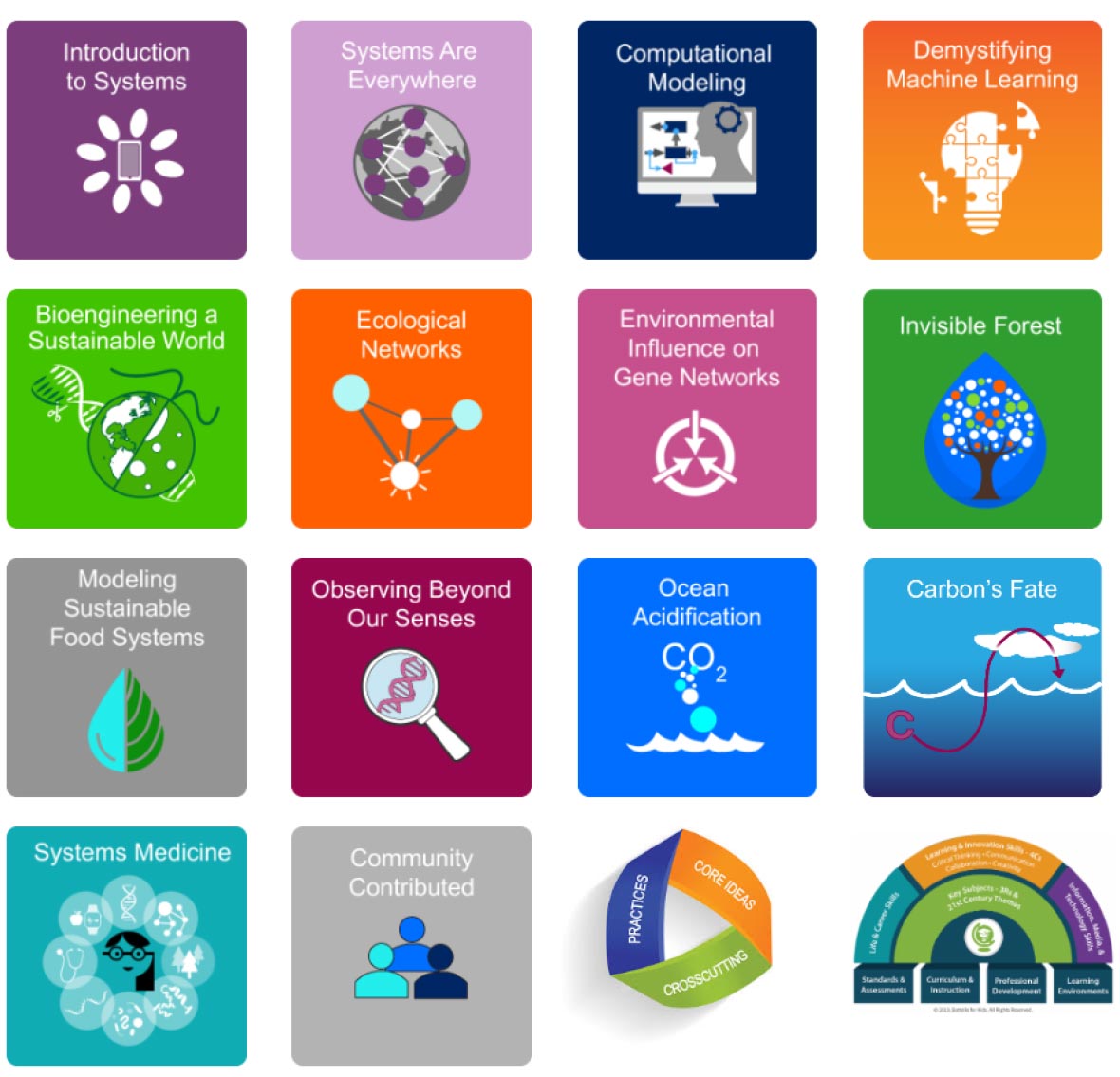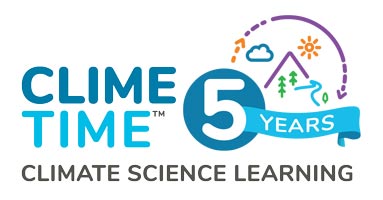Institute for Systems Biology
ISB, Institute for Systems Biology, is first and foremost a science research institute so we in the education group have a unique perspective on STEM education and offer the extremely relevant experience of our own STEM-professionals in all of our education work.
ISB is a valued education partner, as reported by educators, for the unique way we incorporate STEM professionals into the K-12 profession learning sessions we design and offer. Light bulbs go off when workshop teachers can identify that all 8 Science and Engineering Practices and all 7 Crosscutting Concepts are part of each STEM professional’s story. High school science teachers find the cutting edge research and content updates as a strong entry point in their journey with WSSLS/NGSS. Elementary and middle school teachers note they value connection to the passionate real world stories of scientific discovery and solutions to current issues. All teachers appreciate the ISB scientists’ understanding and value of the day-to-day work of K-12 science teachers.
ISB’s education team draws experience from years as pivotal leaders in science education, where we have worked as teachers, administrators, scientists, curriculum developers, and education researchers. ISB Education has 20+ years of experience forming long term partnerships with school districts to support growth of K-12 science programs. We design projects to meet the needs of diverse students, and a key way to do this is to work with all the science teachers in a system, so that the attitudes and beliefs about student learning are raised collaboratively. Therefore, we design projects to be systemic, across a whole district or grade band, that provide multiple years of professional learning strategically laid out along our Science Teacher Professional Growth Continuum.
OER & Classroom Resources
Among ISB’s ever-growing set of high school problem-based-learning modules, are several that provide exemplary supplementary units for climate science issues and standards. ISB hosts and regularly updates a teacher-friendly website for all the OER materials we use in the ClimeTime workshops; please view at https://see.isbscience.org/. New resources were added during the past school year with remote-learning and hybrid-learning strategies and formats.

Professional Learning Experiences
ISB weaves through each workshop series the 3-Dimensions of student science learning:
- DCIs – What students learn
- SEPs – What students do
- CCCs – What students think
The professional learning experiences follow our learning arc for educators — this develops teachers’ practice in a way that results in their students building their own STEM identity and increasing aspiration for STEM occupations.
- Personal learning by each teacher through experiencing contemporary important STEM content, careers, and approaches.
- Professional learning via teachers collaborating to prepare for instruction using best practices. Student voice strategies (learning progress heat maps, clicker surveys, reflection boards, and more) are modeled for and practiced by teachers.
- Action for student learning happens through teachers engaging their students in STEM learning experiences that build students’ aspiration for STEM career pathways, and by teachers analyzing evidence of learning across this network of educators.
Teacher Professional Learning
“Teachers Inspiring Science Students — CCCs in action to learn climate science: a ClimeTime project by ISB with ESD + district partners”
Features:
-
- We use a Systems Approach, working with teams of teacher colleagues towards equitably supporting each student.
- We facilitate STEM Professionals to engage with teachers around climate science issues, current research, and personal stories of life/school pathways in STEM fields.
- We model the use of a range of exemplary OER resources including ISB developed modules that provide authentic science investigations that engage students and bridge the distance between the professional lab and the classroom.
- We make the Crosscutting Concepts come to life, emphasizing their importance for each and every student, every grade throughout K-12 and exploring strategies for authentically integrating them into the classroom.
- We support teachers to observe student learning including using practical measures as they implement.
Results from 2020-2021 in partnership with ESDs:
ISB’s education team has a 20+ year track record of forming and nurturing science education partnerships in WA, through direct work on science reform projects in the greater Puget Sound region and statewide through Washington State LASER.At the time of the SARs-CoV-2 outbreak, ISB partnered with PSESD-121’s ClimeTime project to offer, urgently, a set of “Systems Are Everywhere!” workshops for teachers to see online science instruction modeled, and to receive coaching in order to implement the lessons in their own classrooms. In total 569 educators from 110 districts across all 9 ESDs participated in ISBs 18 ClimeTime workshops, and many of these teachers that sought out and participated were not those traditionally included in science professional development for in-depth support linking WSSLS and climate science. Please see the ClimeTime impacts report from school year 2020-21 at https://tinyurl.com/ISBFY2021.
Workshops
Crosscutting Concepts Woven Through Core Science Units
Grade levels 6-12: Middle and High School (Science/STEM/CTE)
10 STEM Clock Hours
Explore the seven Crosscutting Concepts (CCCs), while practicing with example lessons how to weave the CCCs into your upcoming science units.
Secondary science teachers, join the ISB team to explore CCCs!
- Introductory Session: January 17, 2024 @ 4:00 pm (Optional 30-minute pre-series introduction overview and how to form a team to participate in the workshops)
- Wednesday, February 7, 2024
- Wednesday, February 21, 2024
- Wednesday, February 28, 2024
- Wednesday, March 13, 2024
Systems Are Everywhere
Grade levels K-12: Elementary, Middle and High School
4 STEM Clockhours
Build systems thinking skills, career connections, and fun explorations of systems into each of your science units. Explore this Open Educational Resource (OER) using Climate Science phenomena.
Teachers of science, any grade K-12, join the ISB team to explore systems!
- Introductory Session: January 9, 4:00pm – 4:30pm (An overview and how to form a team to participate in the two workshops)
- Workshop 1: January 23, 4:00pm – 6:00pm
- Workshop 2: January 25, 4:00pm – 6:00pm
3D NGSS High School Science Academy: Using OpenSciEd ROUTINES in high school science courses for 3D science learning by each student
Grade levels 9-12: High School (Science/STEM/CTE)
9 STEM Clock Hours
Supporting high school science teachers by adding science ROUTINES for engaging every student in sense making and learning. Practice how to weave these student routines into upcoming science units. Explore this Open Educational Resource (OER) using Climate Science phenomena.
Coming soon.
SEE Modules: To prepare to implement a high school unit with climate science themes
Grade levels 6-12: Middle and High School (Science/STEM/CTE)
STEM Clock Hours
Engage biology, chemistry and physics students with Climate Science Open Educational Resource (OER) problem-based learning
Secondary science teachers, join the ISB team to engage bio/chem/physics students with Climate Science OER problem-based learning!
- Cohort 1: Tuesdays 4:00-5:30pm
- January 30, February 6, February 13, February 27, March 5, March 12, 2024.
–or–
- Cohort 2: Thursdays 4:00-5:30pm
- March 21, March 28, April 4, April 18, April 25, May 2, 2024.
The purpose of this 9-hour series of workshops is to provide weekly guidance for teachers to learn about all six available Systems Education Experiences (SEE) Modules (listed below) from Institute for Systems Biology that are climate-themed. The purpose of learning about the modules is to give teachers the ability to implement the pertinent lessons, pedagogical strategies, and/or entire modules in your classroom.
Modules available to implement:
- OCEAN ACIDIFICATION: Leading your class through collaborative ocean acidification research that leads to hope and action.
- INVISIBLE FOREST: Using STEAM, project-based learning, and big data to investigate the invisible forest.
- BIOENGINEERING A SUSTAINABLE WORLD: Using STEM and algae to bioengineer a more sustainable world
- CARBON’S FATE: Using hands-on investigations and big data to understand carbon’s influence on ocean and earth systems and why it matters.
- FOOD SECURITY: Guide students through an interdisciplinary STEM approach to understanding and taking action to improve food security.
- ECOLOGICAL NETWORKS: Lead your students through a collaborative hands-on microbiology investigation that uncovers reverberating effects in ecological networks.
Ask us about customizing workshops, district-wide STEM support, and more at education@isbscience.org.
Explore More
Ask us about customizing workshops, district-wide STEM support, and more at education@isbscience.org
Partners & Collaborators
- PSESD 121
- School district teams of teachers
I thought the idea of having an actual Scientist come into my classroom, or virtual classroom as it stands right now, would just be exciting for my students. I want to reach out to someone right away and see if they would be willing to visit us.
The scientist mentioned different career opportunities for different levels of education which would be great to share with my students.
Wonderful intro to systems thinking, the scientist interactions made it “real”, my brain is full!
Success Stories from Institute for Systems Biology
Systems are Everywhere!
The Systems Are Everywhere! Workshop was developed and led by the Institute for Systems Biology in collaboration with the Puget Sound ESD.
Climate Science through Chemistry
The rationale for this project is to support high school chemistry teachers for leading change.



